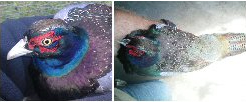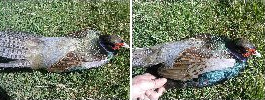Other Names: Japanese Pheasant, Versicolor Pheasant
Range: Japan; introduced to the Hawaiian Islands and western Europe.
Subspecies: Three: Southern Green Pheasant (P. versicolor versicolor), Pacific Green Pheasant (P. v. tamensis), Northern Green Pheasant (P. v. robustipes).
Habitat: Light wooded areas near cultivated lands and meadows.
The males have the crown green, the throat blue, and the neck purplish violet; the mantle is green with a few small buff vermiculations on its lower part; back and rump green, much tinged with olive or blusih grey; rectrices dark olive with broad, black bars and pinkish fringes; scapulars barred black and pale buff with a chestnut fringe and a green tip; wing-coverts light grey tinged with blue green, the greater part much marked with chestnut; flight feathers as in other True Pheasants; underparts dark green slightly tinged with blue or purple, the feathers, as those of the mantle, deeply indented. Size small: wing: 215-243 mm; tail: 270-425 mm; tarsus: 64-78 mm; culmen: 29-38 mm.
The female is more strongly mottled than that of colchicus; the dark part of the feathers of the mantle is black and extends right up to the narrow, pale brown border, and it has a green sheen near the tip; the under parts are more vermiculated and blotched than in any other form of True Pheasant. Wing: 195-220 mm; tail 207-275 mm; tarsus: 55-64; culmen: 25-33 mm.
Breeding Season: April to early June.
Breeding Age: First year; adult plumage is also attained the first year.
Clutch Size: 6 to 12 olive eggs.
Incubation Period: 23 to 25 days.
Northern Green Pheasant, Phasianus versicolor robustipes

Southern Green Pheasant, Phasianus versicolor versicolor



